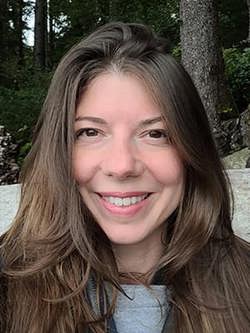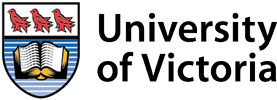Home / Science and the Environment / Transforming data into insight with GIS
Transforming data into insight with GIS

By Portia Yip, Marketing Services
“Geographic Information Systems (GIS) is a technology that uses maps and data to understand the world around us,” says Jessica Neal.
Jessica is an instructor in the new GIS Skills and Mapping micro-certificate with Continuing Studies at UVic and a seasoned expert in GIS and spatial data science. From managing forests and planning cities, to protecting marine ecosystems and guiding humanitarian responses, GIS is used to solve real-world problems.
“If you have GIS training, you can adapt those skills to a lot of different areas, which means you can collaborate across disciplines,” Jessica describes. “You can create creative solutions for different industry, government, or healthcare services.”
A decade of experience in spatial science

Jessica has spent more than 10 years instructing GIS courses at the University of Victoria, and the last two years teaching with Continuing Studies. With a professional background in geography and spatial data science, her expertise combines academic research with practical application.
Beyond teaching, Jessica has developed web-based GIS tools to support everything from ecological restoration to climate change response and mental health services. This diversity of experience reinforces what she believes to be one of GIS’s greatest strengths: its versatility.
“GIS is about layering information and data to see patterns in human dynamics,” Jessica shares. “If you enjoy interacting with maps, data or scientific discoveries, you’ll enjoy gaining skills in GIS.”
What is GIS and why is it important?
At its core, GIS is a technology that combines maps and data to explain what’s happening, where, and why. By integrating different layers, GIS allows us to detect trends, uncover relationships, and make informed decisions.
Here are five things to know about GIS:
- GIS is the study of data and location: GIS helps to explain why events happen in different places.
- GIS is more than just maps: Spatial analysis can reveal trends, predict outcomes, and guide decisions (e.g.,mapping the intersection of marine life with shipping lanes to ensure conservation management).
- GIS is highly versatile: GIS skills are valued in forestry, agriculture, urban planning, public policy, advocacy and more.
- GIS expertise takes a commitment to lifelong learning: Employment in the GIS industry requires a combination of the latest software and programming skills, plus strong problem-solving abilities.
- GIS turns complex data into clear information: Learning to communicate through maps and apps is the key to success for students or professionals.
Passion projects and career readiness
The GIS Skills and Mapping program is designed for both beginners and professionals who are interested in applying GIS in meaningful ways. Each module challenges students to create a portfolio-ready map project on a topic that matters to them.
“Students love that they can apply what they learn to their own passions,” Jessica shares. “One mapped out seagrass areas off the coast as a project, and another student become so engaged with remote sensing that they went ahead and independently taught themselves how to do vegetation index mapping.”
Throughout the program, topics to explore may include:
- species and ecosystem mapping
- recreation map planning
- database management using open-source data
- land use and climate change adaptation
Each module focuses on gaining fundamental, critical skills in spatial data collection, map design, and communicating findings and products.
Building the skills to meet industry demands
The GIS industry is growing rapidly, with high demand in government, environmental science, engineering services and geologic analysis. Recent statistics from the Government of Canada’s Job Bank shows that 92 per cent of GIS workers are employed full-time. Many professionals earn between $75,000 to $100,000 annually and top employers are in the public and private sectors.
Jessica frequently connects with employers like GeoBC to understand evolving skill demands. Across the board, one theme is consistent: organizations need professionals who can manage complex data, think critically, and communicate insights clearly.
“Refining large datasets into digestible, decision-ready products is essential,” Jessica describes. “GIS is fast-paced, and you have to be adaptable and self-motivated.”
Why choose GIS training?
GIS is not just a skill set—it’s a way of thinking. With GIS training, you can collaborate across disciplines, adapt to emerging technologies, and create tools that inform policy, protect natural resources, or improve communities.
“GIS transforms complex data into clarity,” Jessica says. “It’s an evolving tool for anyone curious about the world.”
In a data-driven world, GIS is at the forefront especially with layering data by location. GIS helps to allocate resources, respond to emergencies, and deliver essential services. For example, GIS can help with:
- disaster responses
- crisis interventions
- route optimization
- urban planning
- climate change research
- business analytics
- disease tracking
- crime prediction
- land management
- cultural inventories
New technologies are also expanding the possibilities of GIS. Tools like drone imagery, LiDAR, and AI-powered assistants such as GIS Copilot and ShapefileGPT are changing and improving workflows.
“Soon, GIS professionals will be solving problems by prompting software to do the heavy lifting,” Jessica says. “The human element—creativity and critical thinking—will be more important than ever.”
For more information and helpful GIS resources, Jessica recommends checking out QGIS Tutorials and Tips and ESRI tutorials.

GIS training starts here
If you're ready to explore how data and maps can change the world—or your career—the Micro-certificate in GIS Skills and Mapping is a great place to start. Whether you want to build interactive maps, support climate adaptation, or plan smarter cities, GIS offers the tools and opportunities to make a difference.
About the instructor
With a doctorate in spatial data science and over 10 years of experience teaching at the University of Victoria, Dr. Jessica Neal offers expertise in Geographic Information Science (GIS). She applies spatial data analysis, modelling, and web mapping to answer complex questions about the environment and human behaviour. She is proficient in the use of GIS software (ArcGIS, QGIS, Google Earth) and programming languages (R, Python) to provide tailored solutions for your mapping needs. She is particularly interested in community outreach projects that provide students with applied learning opportunities. To learn more about her research accomplishments visit her Research Gate profile.
- Posted July 3, 2025
Visit Registration
2nd Floor | Continuing Studies Building University of Victoria Campus 3800 Finnerty Road | Victoria BC | CanadaTel 250-472-4747 | Email uvcsreg@uvic.ca
2026 © Continuing Studies at UVic
Legal Notices |
Sitemap

